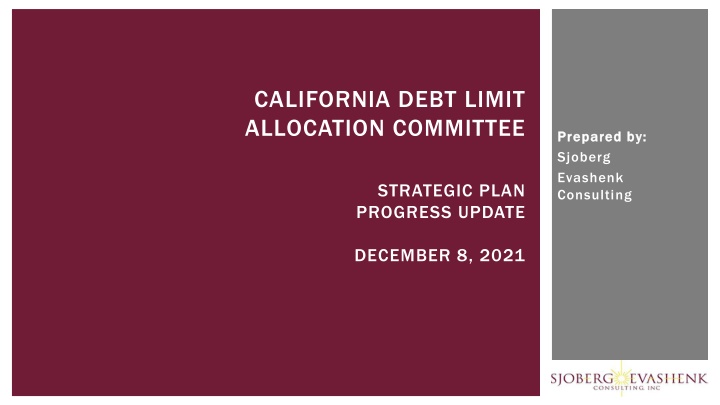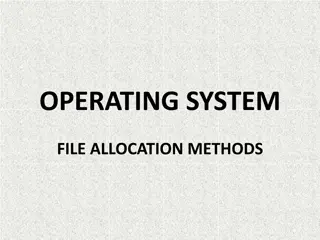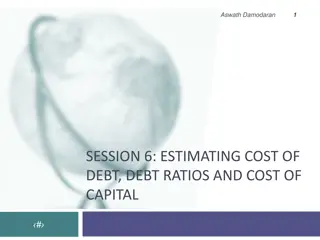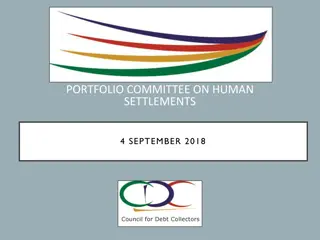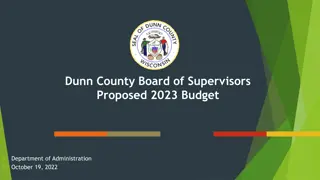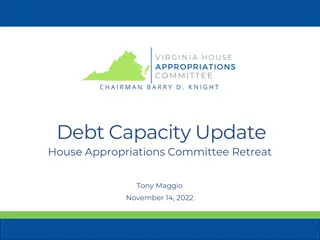Strategic Plan Progress Update for California Debt Limit Allocation Committee
The California Tax Credit Allocation Committee has hired Sjoberg Evashenk Consulting to develop a strategic plan to address coordination issues with the California Debt Limit Allocation Committee. The plan aims to align resources, staffing, and regulations to meet affordable housing objectives and enhance organizational efficiency. Key observations highlight the potential for greater coordination between the committees despite current disjointed efforts. Outdated technology and lack of standardized processes hinder productivity and create inefficiencies.
Download Presentation

Please find below an Image/Link to download the presentation.
The content on the website is provided AS IS for your information and personal use only. It may not be sold, licensed, or shared on other websites without obtaining consent from the author.If you encounter any issues during the download, it is possible that the publisher has removed the file from their server.
You are allowed to download the files provided on this website for personal or commercial use, subject to the condition that they are used lawfully. All files are the property of their respective owners.
The content on the website is provided AS IS for your information and personal use only. It may not be sold, licensed, or shared on other websites without obtaining consent from the author.
E N D
Presentation Transcript
CALIFORNIA DEBT LIMIT ALLOCATION COMMITTEE Prepared by: Prepared by: Sjoberg Evashenk Consulting STRATEGIC PLAN PROGRESS UPDATE DECEMBER 8, 2021 1
PROJECT OBJECTIVES The California Tax Credit Allocation Committee (CTCAC) hired Sjoberg Evashenk Consulting, Inc., to facilitate the development of a strategic plan that is consistent with the statutory duties of the California Debt Limit Allocation Committee (CDLAC) and the California Tax Credit Allocation Committee (CTCAC). The objective of the strategic plan is to: Evaluate steps the organizations can take to address the State Auditor s November 2020 findings and recommendations, which found that the lack of coordination and planning between CTCAC/CDLAC has hindered each agency s ability to fulfill their respective directives and recommended the consolidation of both agencies and the delegation of CDLAC s bond allocation authority to CTCAC. Better align CTCAC and CDLAC organizational resources, staffing and regulations to achieve the State of California s affordable housing objectives. Identify additional improvements necessary to effectively and efficiently execute the statutory responsibilities and purposes of CTCAC and CDLAC. SJOBERG SJOBERG EVASHENK 2 3/9/2025 EVASHENK
PROJECT APPROACH To meet this objective, we performed the following procedures: Reviewed background information, regulations, policies and procedures, standard forms and applications, and other background materials. Interviewed more than 70 CTCAC/CDLAC personnel. Evaluated the organizational structures of CTCAC and CDLAC, including the allocation of staffing resources to manage growing workloads. Reviewed the core programs and services offered by CTCAC and CDLAC, including mapping business processes. Evaluated the technological resources available to both agencies, including technology used perform core functions; automate previously manual processes; track workflows and maintain related records; and maintain official records of CTCAC and CDLAC analyses, conclusions, and actions. As of November 30, this analysis is approximately 70% complete. SJOBERG SJOBERG EVASHENK 3 3/9/2025 EVASHENK
KEY OBSERVATIONS CDLAC and CTCAC are well-positioned for greater coordination and alignment, and efforts have been made over the past several years to enhance coordination. The majority of tax-free bond allocations issued by CDLAC overlap with tax credit allocations issued by CTCAC. The workflows developed by CDLAC and CTCAC (including application receipt, review, ranking, and servicing) parallel one another. Both organizations share a similar stakeholder base and often provide allocations to the same developers and projects. Despite Parallels in Programs and Workflows, the Efforts of CDLAC and CTCAC are Disjointed and Siloed Both CDLAC and TCAC utilize outdated and antiquated Information Technology that is not capable to meet current business needs. Several factors impede the ability of CDLAC and CTCAC to optimize the productivity of staffing resources. Business processes lack adequate standardization within each organizations, and inconsistencies in regulations between organizations create confusion and inefficiencies for applicants and staff. SJOBERG SJOBERG EVASHENK 4 3/9/2025 EVASHENK
PROBLEM #1 Despite Parallels in Programs and Workflows, the Efforts of CDLAC and CTCAC are Disjointed and Siloed CDLAC and CTCAC regulations are not aligned and occasionally conflict, resulting in discrepancies during application review and processing, and inefficiencies for both staff and applicants. Efforts are currently underway to identify and resolve conflicts in regulations, particularly relating to CDLAC regulations that conflict with CTCAC regulations. We recommend that this continue. CDLAC and CTCAC staff resources are not aligned. Stakeholders submit applications to both organizations for the same projects, and each organization reviews and ranks the applications independently. If problems are identified, each follows up with the developer separately. While greater coordination between CDLAC and CTCAC may be achieved between the two independent organizations, the overlap between the two organizations and the inherent redundancies associated with dual reviews supports the State Auditor's recommendation to consolidate CDLAC into CTCAC. At the same time, we do not find that consolidation alone will resolve this problem in a cost-effective manner. In addition to consolidation, we recommend that the organization assign workload to staff based on the applicant and/or project, not based on the program (e.g., bond authority or tax credit). Recommendation: Strive to achieve a one-stop-shop model that results in a single point of contact for each project and each phase of the allocation process. SJOBERG SJOBERG EVASHENK 5 3/9/2025 EVASHENK
PROBLEM #2 CDLAC and CTCAC utilize outdated information technology that does not meet current needs. Current information technology resources rely on paper files and manual workflows, requiring staff to perform their work on paper or in Excel workbooks, only to convert their work to electronic format after- the-fact. This fails to streamline business processes, is prone to error, and requires duplication of effort. Information is stored in the database, network drives, FileNet, and paper files, resulting in an ineffective and inefficient record management process, increasing the risk that records may be lost, and incentivizing staff to save personal copies of records in an ad hoc manner. CDLAC and CTCAC utilize different databases to record information related to their allocations; maintaining dual databases make the organizations less agile in responding to updated regulations and efforts to streamline application processes or interfacing with other state agency systems. Databases, which often freeze when in use, do not have the current functionality to generate timely reports necessary to enable management to track performance metrics, volume statistics, or other indicators of operational effectiveness or output. Recommendation: CDLAC/CTCAC should implement a comprehensive IT overhaul that results in an information technology solution that manages the workflow associated with application receipt and processing, bond authority and tax credit allocations, compliance efforts, and record management. SJOBERG SJOBERG EVASHENK 6 3/9/2025 EVASHENK
PROBLEM #3 High turnover and sustained vacancies have impacted both CDLAC and CTCAC, contributing to the loss of institutional knowledge and key resources for resolving complex problems; backlogs, overtime, or work that remains unfinished; and the need to outsource certain compliance functions in order to maintain compliance with IRS inspection cycles. While Staff cited operational inefficiencies, the lack of adequate information technology resources, and duplication of efforts as reasons for low morale, they noted three key factors contributing to the difficulties recruiting and retaining staff: (a) restrictive remote work policies, (b) significant travel requirements, and (c) the shortage of adequate office space and requirements to share workstations. This is most felt in CTCAC s compliance unit, where sustained vacancy rates are impacting the division s ability to meet mandatory inspection timelines. Staff cited several factors contributing to the vacancy rates, including restrictive requirements related to remote work and, as the pandemic subsides, the prospect of substantial travel. Recruiting candidates to fill positions with substantial travel requirements and limited to no remote work options will prove challenging to CTCAC. Recommendation: Given the realities of today s labor market, consideration should be given to developing remote work options for certain CDLAC and CTCAC positions and reducing CTCAC travel requirements for compliance staff by establishing a Southern California presence. SJOBERG SJOBERG EVASHENK 7 3/9/2025 EVASHENK
PROBLEM #4 Business processes lack adequate standardization within each organizations, creating an over-reliance on long-term employees' institutional knowledge. CDLAC and CTCAC lack sufficient formal policies and procedures to guide how staff perform their work and apply regulations. Practices often rely on institutional knowledge of long-term staff; as turnover increases, this knowledge is lost. Even standard processes become individualized over time (e.g., Excel workbooks used to evaluate applications), increasing the potential for inconsistencies. Undocumented processes risk breakdowns in internal controls (e.g., receipt of fees and release of performance deposits [CDLAC]). Business practices are generally sufficient to complete required tasks by established deadlines (e.g., scheduled committee meetings); in this manner they can be considered effective. However, inefficiencies in the processes result in extra work for staff, creating undue pressure and contributing to a less productive work environment. Recommendation: The potential consolidation of CDLAC and CTCAC, and the potential implementation of a new information technology solution, will require the organization to re-evaluate its business processes. In so doing, it should develop formal policies and procedures designed to standardize processes and reduce reliance on individual-dependent institutional knowledge. SJOBERG SJOBERG EVASHENK 8 3/9/2025 EVASHENK
George Skiles, Partner Sjoberg Evashenk Consulting 455 Capitol Mall, Suite 700 Sacramento, CA 95814 (916) 443-1300 george@secteam.com SJOBERG SJOBERG EVASHENK 9 3/9/2025 EVASHENK
